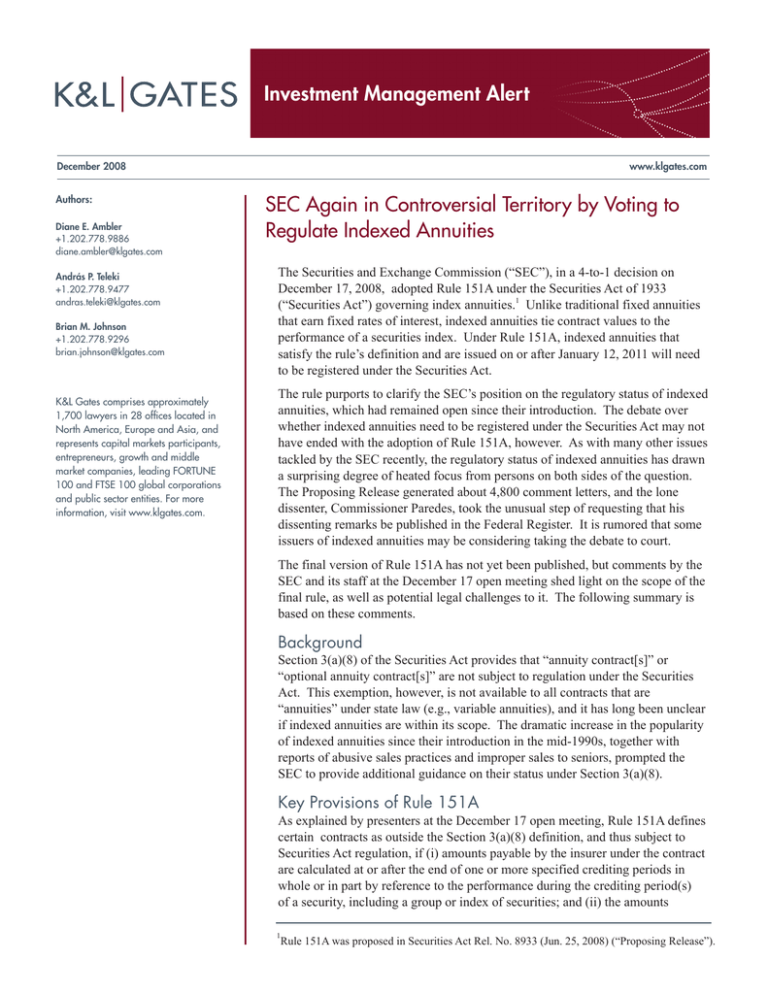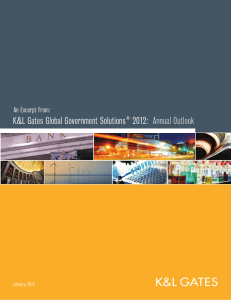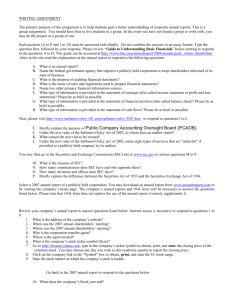
Investment Management Alert
December 2008
Authors:
Diane E. Ambler
+1.202.778.9886
diane.ambler@klgates.com
András P. Teleki
+1.202.778.9477
andras.teleki@klgates.com
Brian M. Johnson
+1.202.778.9296
brian.johnson@klgates.com
K&L Gates comprises approximately
1,700 lawyers in 28 offices located in
North America, Europe and Asia, and
represents capital markets participants,
entrepreneurs, growth and middle
market companies, leading FORTUNE
100 and FTSE 100 global corporations
and public sector entities. For more
information, visit www.klgates.com.
www.klgates.com
SEC Again in Controversial Territory by Voting to
Regulate Indexed Annuities
The Securities and Exchange Commission (“SEC”), in a 4-to-1 decision on
December 17, 2008, adopted Rule 151A under the Securities Act of 1933
(“Securities Act”) governing index annuities.1 Unlike traditional fixed annuities
that earn fixed rates of interest, indexed annuities tie contract values to the
performance of a securities index. Under Rule 151A, indexed annuities that
satisfy the rule’s definition and are issued on or after January 12, 2011 will need
to be registered under the Securities Act.
The rule purports to clarify the SEC’s position on the regulatory status of indexed
annuities, which had remained open since their introduction. The debate over
whether indexed annuities need to be registered under the Securities Act may not
have ended with the adoption of Rule 151A, however. As with many other issues
tackled by the SEC recently, the regulatory status of indexed annuities has drawn
a surprising degree of heated focus from persons on both sides of the question.
The Proposing Release generated about 4,800 comment letters, and the lone
dissenter, Commissioner Paredes, took the unusual step of requesting that his
dissenting remarks be published in the Federal Register. It is rumored that some
issuers of indexed annuities may be considering taking the debate to court.
The final version of Rule 151A has not yet been published, but comments by the
SEC and its staff at the December 17 open meeting shed light on the scope of the
final rule, as well as potential legal challenges to it. The following summary is
based on these comments.
Background
Section 3(a)(8) of the Securities Act provides that “annuity contract[s]” or
“optional annuity contract[s]” are not subject to regulation under the Securities
Act. This exemption, however, is not available to all contracts that are
“annuities” under state law (e.g., variable annuities), and it has long been unclear
if indexed annuities are within its scope. The dramatic increase in the popularity
of indexed annuities since their introduction in the mid-1990s, together with
reports of abusive sales practices and improper sales to seniors, prompted the
SEC to provide additional guidance on their status under Section 3(a)(8).
Key Provisions of Rule 151A
As explained by presenters at the December 17 open meeting, Rule 151A defines
certain contracts as outside the Section 3(a)(8) definition, and thus subject to
Securities Act regulation, if (i) amounts payable by the insurer under the contract
are calculated at or after the end of one or more specified crediting periods in
whole or in part by reference to the performance during the crediting period(s)
of a security, including a group or index of securities; and (ii) the amounts
1
Rule 151A was proposed in Securities Act Rel. No. 8933 (Jun. 25, 2008) (“Proposing Release”).
Investment Management Alert
payable by the insurer under the contract are
“more likely than not” to exceed the amounts
guaranteed under the contract.
Furthermore, an insurance company’s
determination, at or before the issuance of a
contract, that the amounts payable under the
contract are (or are not) “more likely than
not” to exceed contractual guarantees will be
conclusive, provided that (i) the insurance
company’s methodology and economic,
actuarial and other assumptions are reasonable,
(ii) the insurance company’s computations are
materially accurate; and (iii) the determination
is made not earlier than six months prior to
the date on which the form of contract is first
offered. In making this determination, surrender
and other charges should be reflected in both the
amounts payable and the amounts guaranteed
under the contract. The SEC staff noted at the
open meeting that this provision is intended to
be “principles-based,” suggesting an intention
that it be open to interpretation.
The staff further indicated that Rule 151A as
adopted differs from the proposed version
in two respects: It does not contain the
requirement that the insurance company reassess the status of each indexed annuity every
three years. Also, the scope of the rule was
narrowed and clarified to address concerns
raised by commenters that, as originally
proposed, it could have been interpreted to
apply to traditional fixed annuities, which was
not the intent.
Commissioner Paredes’s Dissent
In his dissent, Commissioner Paredes presented
the legal analysis reflected in a number of
comment letters opposing the rule. Among
other things, he asserted that Rule 151A exceeds
the SEC’s statutory authority and interpreted
the precedents of the SEC and the courts to not
support regulation of indexed annuities under
the Securities Act. He noted that the approach
taken in Rule 151A is contrary to the seminal
Supreme Court cases interpreting Section 3(a)
(8), SEC v. Variable Annuity Life Ins. Co. of
Am. (359 U.S. 65 (1959)) and SEC v. United
Benefit Life Ins. Co. (387 U.S. 202 (1967)), as
well as a federal court that concluded certain
indexed annuities are not securities (see Malone
v. Addison Ins. Mktg., Inc., 225 F. Supp. 2d 743
(W.D. Ky. 2002)). He also stated that Rule
151A is inconsistent with the position taken by
the SEC itself in an amicus brief it submitted
in a petition for certiorari before the Supreme
Court in the case of Otto v. Variable Annuity
Life Ins. Co. (814 F.2d 1127 (7th Cir. 1987).
Commissioner Paredes also took issue with
Rule 151A’s concept of investment risk (which
in his view focuses on upside, rather than
downside, risk) and other practical concerns
such as the uncertainty caused by a “more likely
than not” test.
Adoption of Rule 12h-7
The SEC also voted to adopt Rule 12h-7, a
companion rule to Rule 151A. Rule 12h-7
exempts insurance companies from certain
reporting requirements under the Securities
Exchange Act of 1934 (“Exchange Act”) with
respect to securities that are either subject
to regulation under the insurance laws of
the insurer’s home state or are guarantees of
securities subject to such regulation. To qualify
for Rule 12h-7, the following conditions must
also be satisfied:
• A
n insurer claiming the exemption must
file an annual statement of financial
condition with, and be supervised and
examined by, the insurance regulator in the
insurer’s home state;
• T
he securities to which the exemption
relates may not be listed, traded, or quoted
on an exchange, alternative trading system,
inter-dealer quotation system, electronic
communications network, or any similar
system;
• T
he insurer must take steps reasonably
designed to ensure that a trading market
does not develop for the securities to which
the exemption applies; and
December 2008 | 2
Investment Management Alert
• T
he prospectus for the relevant securities
must contain an express statement that the
issuing insurance company is relying on the
exemption.
Commenters at the December 17 open
meeting noted two differences between the
rule as adopted and that as proposed. First,
to address some commenters’ concerns that
the requirement to restrict transferability was
inconsistent with state law, the staff stated that
nothing had to be done that was inconsistent
with state law requirements. Second, the
provision regarding prospectus notice regarding
an insurer’s reliance on the exemption was
added to permit an insurer to choose to continue
to be an Exchange Act reporting company rather
than to rely on the exemption. If the requisite
language is not included in the prospectus, the
insurer must continue to comply with Exchange
Act reporting requirements. The effective date
of Rule 12h-7 was not discussed at the open
meeting.
K&L Gates comprises approximately 1,700 lawyers in 28 offices located in North America, Europe and Asia, and represents capital markets
participants, entrepreneurs, growth and middle market companies, leading FORTUNE 100 and FTSE 100 global corporations and public sector
entities. For more information, visit www.klgates.com.
K&L Gates comprises multiple affiliated partnerships: a limited liability partnership with the full name K&L Gates LLP qualified in Delaware and
maintaining offices throughout the U.S., in Berlin, in Beijing (K&L Gates LLP Beijing Representative Office), and in Shanghai (K&L Gates LLP Shanghai
Representative Office); a limited liability partnership (also named K&L Gates LLP) incorporated in England and maintaining our London and Paris
offices; a Taiwan general partnership (K&L Gates) which practices from our Taipei office; and a Hong Kong general partnership (K&L Gates,
Solicitors) which practices from our Hong Kong office. K&L Gates maintains appropriate registrations in the jurisdictions in which its offices are
located. A list of the partners in each entity is available for inspection at any K&L Gates office.
This publication is for informational purposes and does not contain or convey legal advice. The information herein should not be used or relied upon
in regard to any particular facts or circumstances without first consulting a lawyer.
©1996-2008 K&L Gates LLP. All Rights Reserved.






